Create
Vintage St. Pete: Piers through the years
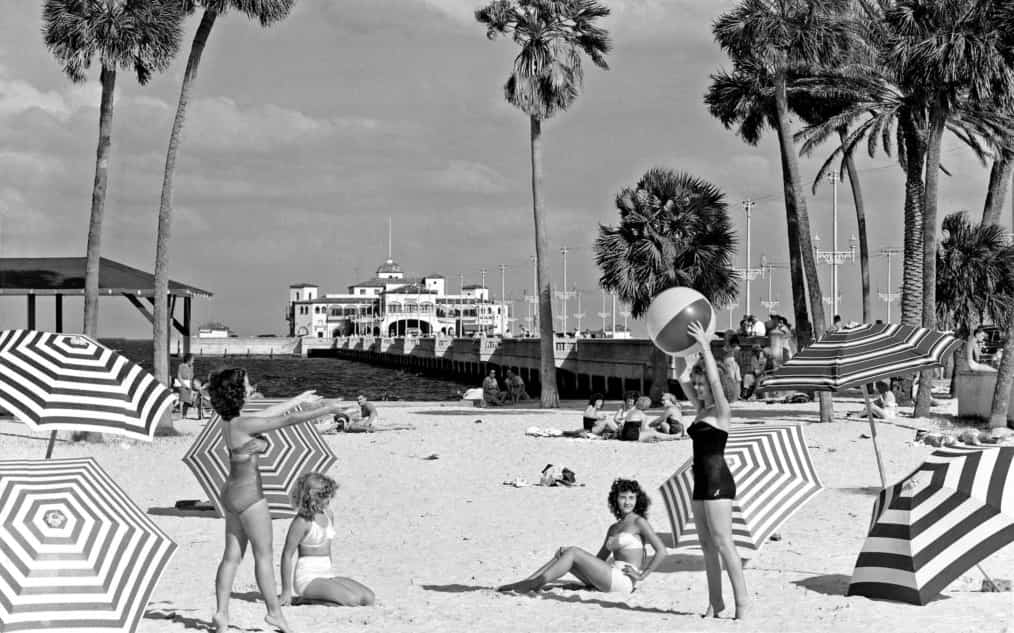
This story appears in the book Vintage St. Pete: The Golden Age of Tourism and More (St. Petersburg Press).
No one in all Florida rejoices more than I in the development of your great city, with its splendid schools and churches … You have added an important milestone in your progress of development, and I have the greatest optimism for St. Petersburg’s future, and I predict even greater progress and prosperity.
U.S. Senator Park W. Trammell, former governor of Florida, dedicating St. Petersburg’s “Million Dollar Pier,” November 25, 1926
There’s been one long pier or another on St. Pete’s eastern waterfront, extending the local footprint into Tampa Bay, for 131 years. The first one, erected in 1889, was an extension of the Orange Belt Railroad, which was itself something new in the city.
Ships with deep drafts could come into the bay and dock at the 3,000-foot Railroad Pier, as it was known, and its cargo would be unloaded directly into boxcars.
Conversely, St. Petersburg exported three million pounds of fish per year in the 1890s. Processing and ice houses were added to the Railroad Pier, as was a small bath house and toboggan-style slide for recreational use (getting to the Gulf beaches, in those days of palmetto thickets, rattlesnake scrub and crude dirt thoroughfares, was difficult for most if not all of the citizenry).
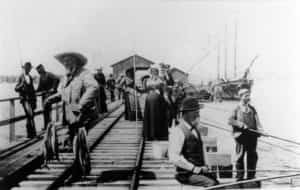
The 1889 Railroad Pier
The arrival of another structure, the 1,500-foot Brantley Pier and its roomy bath house, set the stage for a battle between industrial and recreational use. The Brantley Pier was replaced by the Electric Pier, which featured electric lamp lights and ran a visitor trolley along an electrified track. Fishing off the Electric Pier became a popular pastime.
The City purchased several miles of waterfront in 1910, to be used as dedicated park space, effectively ending the battle.
Three years later, the waterfront park system received a new structure, the St. Petersburg Municipal Recreation Pier, strong and sturdy enough to support two-way vehicular traffic. At its zenith was a shaded wooden pavilion, where visitors could sit quietly and watch the birds and the boat traffic on Tampa Bay.
There was an indoor saltwater swimming pool; this structure, a few years later, became the home of the St. Petersburg Museum of History.
The Electric Pier, just 10 feet south of the Municipal, was demolished in 1914. The Railroad Pier would stand, weak and decaying, until it was taken down in 1952.

1913: The city’s first Municipal Pier, left, and the Electric Pier.
Pier 1926
The Hurricane of 1921 destroyed the Municipal Pier, and the City set about to design and build a sturdy replacement (also destroyed in the storm was the privately-owned “Fountain of Youth Pier,” at 1st Street and 5th Avenue South).
The new city pier had to be something special, too, because tourism – steady, warm weather, beaches and plentiful citrus fruit – was now St. Petersburg’s calling card.
It was Lew Brown, the flamboyant editor of the Evening Independent newspaper, who began a $1 million fundraising campaign. Brown and his readers raised $300,000 towards the project he called the “Million Dollar Pier,” and through a bond issue the City came up with the rest.
And so the “modern era” of city-owned concrete piers began. Extending 1,452 feet into the bay, the new Municipal Pier was formally dedicated on Thanksgiving Day, Nov. 25, 1926, with a crowd of 10,000 in attendance.

The “Million Dollar Pier,” bay view. Postcard image.
It was one of the grandest celebrations in St. Petersburg history as the city’s first airfield, named for local developer Walter Fuller, was dedicated on the same day. The 32-acre Fuller Flying Field was located between 22nd Avenue North and Tyrone Boulevard, the site of contemporary Tyrone Square Mall.
The airfield named for naval aviator Albert Whitted, still in existence today, would not break ground for another four years.
The day was filled with parades, band performances, airplane flyovers and speedboat demonstrations. As it was Thanksgiving, there were public, formal religious services.
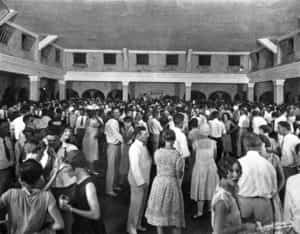
A public dance inside the casino.
The Pier, of course, was the main attraction, as it was something every citizen could enjoy. At the head was a Mediterranean Revival-style casino building, which included a ballroom for concerts, dances and conferences; the office space in the upper level was home to the studios of WSUN, the city’s first radio station (WSUN-TV, the first TV station, broadcast from the pier between 1952 and 1970).
Spa Beach was dredged from the bay bottom, created as the downtown alternative to the (relatively) far-away Gulf shore.
Both beach and pier were fully segregated at the time (as had been the “spa” saltwater swimming pool); in fact, it would be 1959 before blacks were allowed to partake of either.
 In 1930 a roofless solarium, for discreet, gender-separated nude sunbathing, was constructed adjacent to the pier.
In 1930 a roofless solarium, for discreet, gender-separated nude sunbathing, was constructed adjacent to the pier.
The stone, roofless building resembled an Egyptian temple and bore a likeness of the sun god, Ra. Images of snakes and birds decorated the edifice, known as the Temple of the Sun. Admission, locker, soap, a towel and shower cost 35 cents. Once inside, guests discovered numerous chairs and benches amid pure white sand. Capacity was 500 people, and the Solarium averaged 400-600 guests daily in season.
St. Petersburg: An Oral History, Scott Taylor Hartzell
In 1961, despite the addition of modern amenities, including private showers and massage rooms, public disinterest forced the Solarium to close. It was right around this time, too, that civic and community voices began to call for replacement of the outdated, dirty and festering “Million Dollar Pier.”
The wrecking ball came for the casino structure in January, 1967.

Pier 1973
St. Petersburg was struggling with a serious image problem in the late 1960s; the perception that it was “God’s Waiting Room,” a dull, sleepy hamlet where old folks lived in trailer parks, napped in the palm tree shade and played 24/7 shuffleboard, had permeated the national consciousness. There was, to be precise, absolutely nothing cool or exciting about St. Petersburg.
In short order, city officials order the removal of the trademark green benches that dotted downtown (not a moment too soon for black residents, who considered the originally off-limits benches unpleasant symbols of the city’s segregated past).
Money was secured for a newer, more contemporary pierhead design.
Architect William Harvard got the contract for his “Inverted Pyramid,” which was wide on top and narrow at the bottom – the idea, he explained, was to give those at ground level a better and less-obstructed view of Tampa Bay.
Plans called for the five-level, $4 million project to debut during the 1970-71 winter season; delays and cost overruns pushed it back to 1973.
 The ribbon was cut on The Pier, as it was called, on a chilly Saturday afternoon, Jan. 13. After a short opening-day parade down Central Avenue from 7th Street, a crowd of “several hundred” (according to the ever-pithy Times columnist Dick Bothwell) watched the dedication ceremonies from the sunny side of the street:
The ribbon was cut on The Pier, as it was called, on a chilly Saturday afternoon, Jan. 13. After a short opening-day parade down Central Avenue from 7th Street, a crowd of “several hundred” (according to the ever-pithy Times columnist Dick Bothwell) watched the dedication ceremonies from the sunny side of the street:
Emcee Marshall Cleaver introduced the Stockdales – Adele and Julian – who will provide entertainment in The Pier’s Brassaloon starting today. Real troupers, the daughter and father, on organ and guitar respectively, led the crowd in “When the Saints Go Marching In,” with enthusiastic hand-clapping to warm numb fingers. One thought of USO shows in Alaska.
The public was allowed in starting Monday, Jan. 15. The Pier included four restaurants, a cocktail lounge and an ice cream bar, all managed by the Marriott Corporation, plus shops, meeting rooms and the requisite baithouse for anglers.
A tram called the Pier Tug made the rounds from the waterfront to the pier head for those who did not care to drive, or walk.
Bayfront Center manager Al Leggat, whose nearby facility was also city-owned, gave Bothwell some good news in June. “Here at the Bayfront, we had 883,000 patrons in a year – October 1971 to October 1972. In half that time, The Pier drew almost as many. You know, for the first time in history the city’s making quite a bit of money from the pier.”
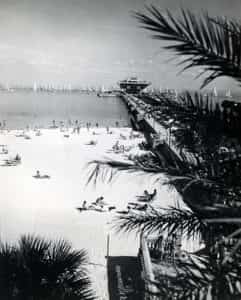 By 1978, however, The Pier’s fortunes were already fading. Repairs to the eroding understructure, from exposure to salt water, came to $500,000. Marriott was replaced by the Hardwicke Corporation, which turned one of the restaurants into a disco.
By 1978, however, The Pier’s fortunes were already fading. Repairs to the eroding understructure, from exposure to salt water, came to $500,000. Marriott was replaced by the Hardwicke Corporation, which turned one of the restaurants into a disco.
The Times reported that year that the City of St. Petersburg would have to subsidize the operation with $177,000 to keep it solvent.
Under consideration was a proposal by an Orlando consulting from to modify the waterfront area into “Pier Park,” with a country fair-type atmosphere including a floating restaurant, rides and games, a botanical garden and more.
“The trouble with downtown is that it isn’t thought of as a place to go,” said city community development director Bruce Hahl.
“I don’t want to give another penny to outside firms when we could do the work ourselves,” councilman Dick Martin said.
Mayor Corrine Freeman was in favor of the overhaul. “The only way the pier is going to be successful is people using it,” she explained. “Tearing it down is not the answer. With the expertise of these consultants, we should be able to have something creative and attractive.”
Meanwhile, the St. Petersburg Police Department assigned extra foot patrol officers to the pier, “to ward off drunks and other undesirables hanging around,” according to the Times.
Pier Park (with a budget of $74 million) was again proposed in the 1980s, and again vetoed.
Despite numerous overhauls, some of them expensive and many more of the simple, Band-Aid variety, The Pier, with its long-outdated Brady Bunch look, stood sentinel over Bayshore Drive and the bay until 2013, when the city finally shuttered it; it was taken down two years later, at a cost of $15 million.
The Columbia Restaurant, Cha Cha Coconuts and Johnny Reno’s Waterfront Restaurant & Watering Hole were no more, and the smattering of shops that remained, four decades after the Pier’s debut, faded into nostalgia.
Pier 2020
The next step in this long civic adventure began July 6, 2020, when the new $92 million pier opened, during the Covid-19 pandemic. With four restaurants, several recreation areas and more greenspace than many city-owned parks covering 26 acres, it is now referred to as the Pier District.
The Pier represents something special to the people of the Sunshine City. It’s an integral part of our skyline. It’s long been a fundamental St. Petersburg icon. So I understand the importance of the Pier to the people of this city … I know that we are going to deliver an exciting new Pier that makes this city proud.
St. Petersburg mayor Rick Kriseman, May 14, 2014
Photographs and postcard images provided by StPetersburgPier.com, the St. Petersburg Museum of History and the Florida Archives.


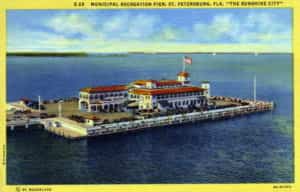
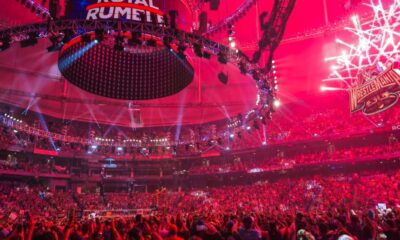





Joan
April 22, 2022at11:48 am
I totally agree with Lillian, King and Brenda. 92 million wasted.
Brenda
February 26, 2022at5:37 pm
I don’t like the new pier
King Blaze
June 16, 2020at12:53 am
In all fairness for $92 million I would never of built that pier. That pier ugly and I’m very ashamed of Saint Petersburg for having outside developers build that type of pier.
James Hendrix
June 15, 2020at8:23 pm
Agreed. It looks finished. Let us go out and discover our new park. I see the Eichelman sculpture is even back up.
Lillian Koziol
June 15, 2020at8:23 am
The new Pier looks like a Mitsubishi car dealership.
Joe Public
June 15, 2020at12:13 pm
WHY do we the people have to wait for an unveiling ceremony? If the pier construction is completed then open the gates. We do not need/want a political speech, we paid for it so just open it!